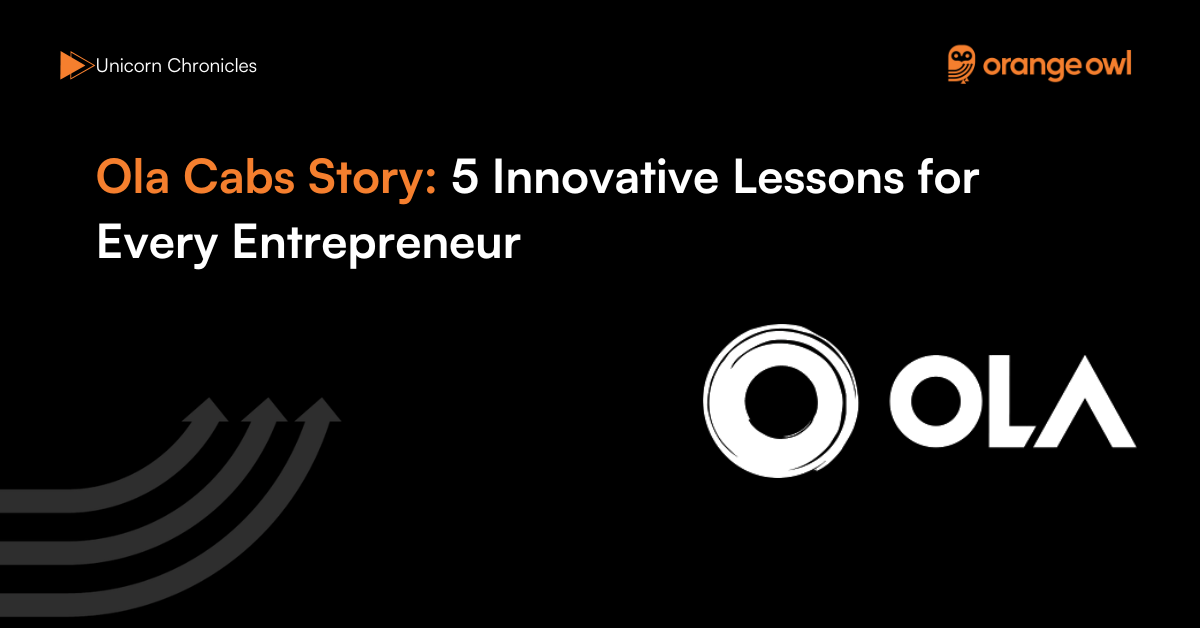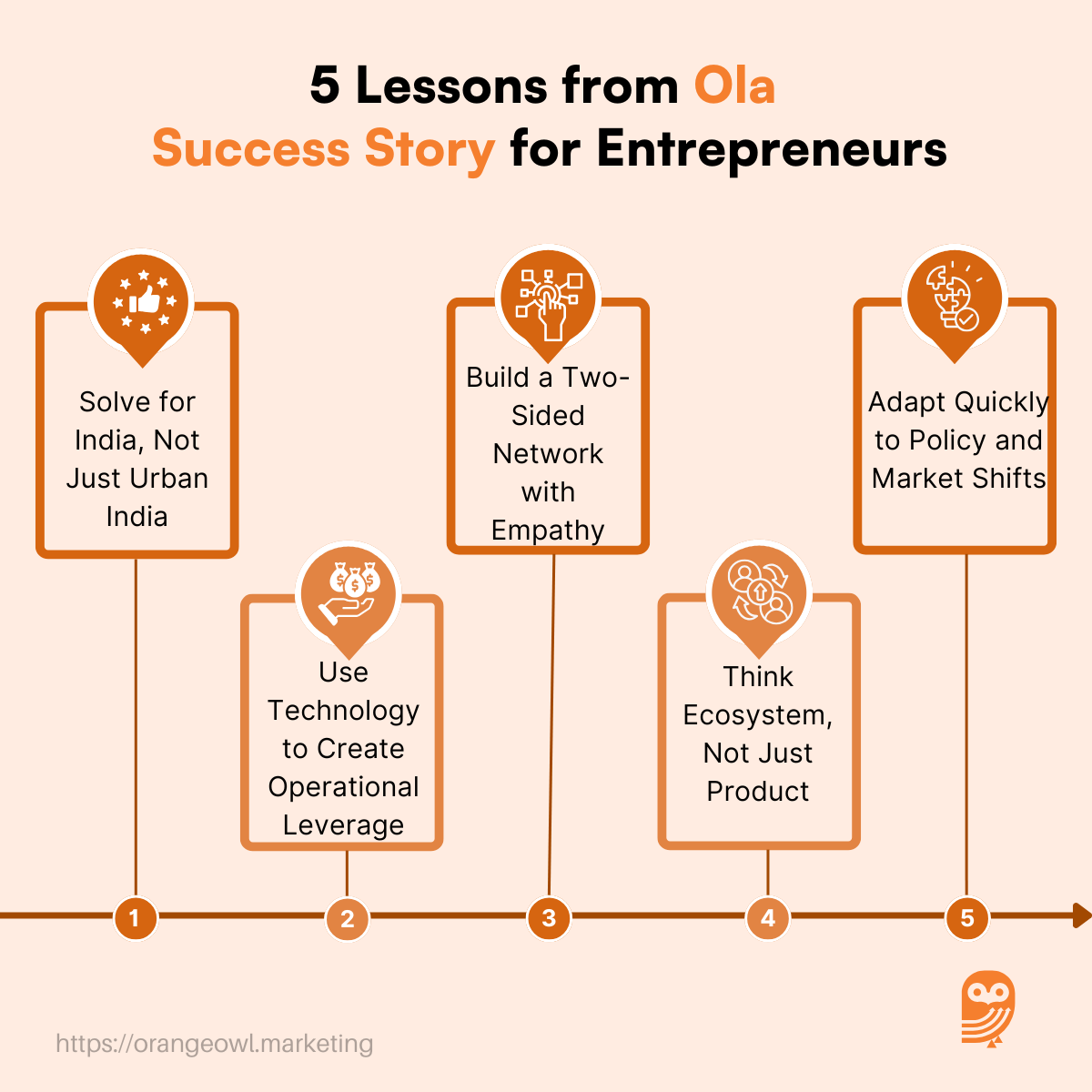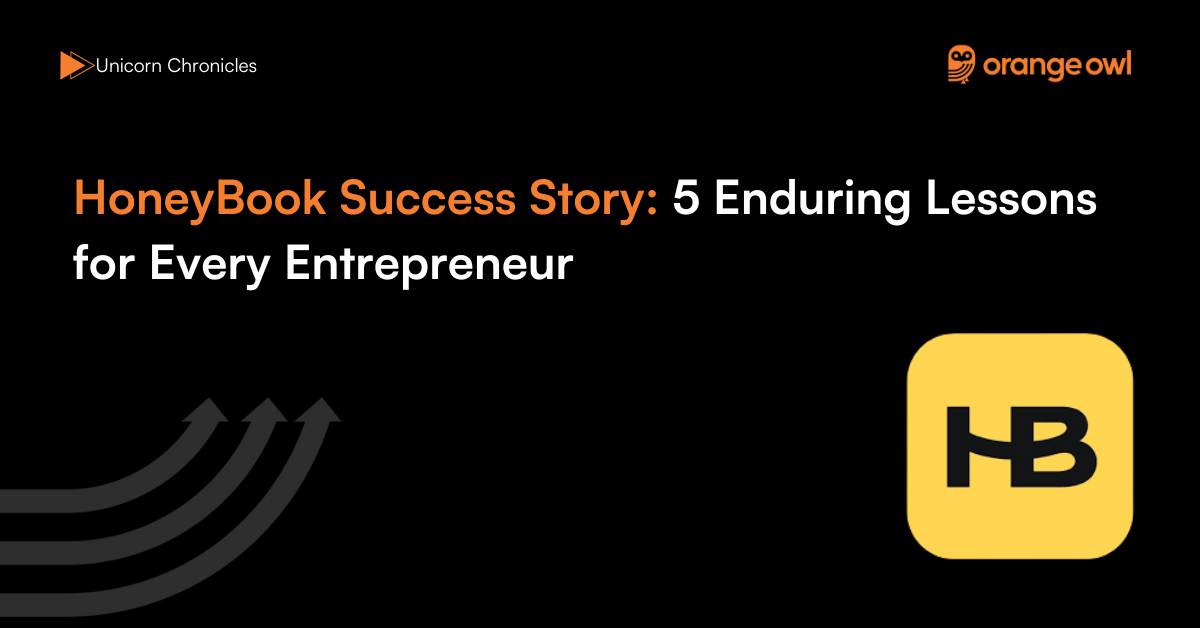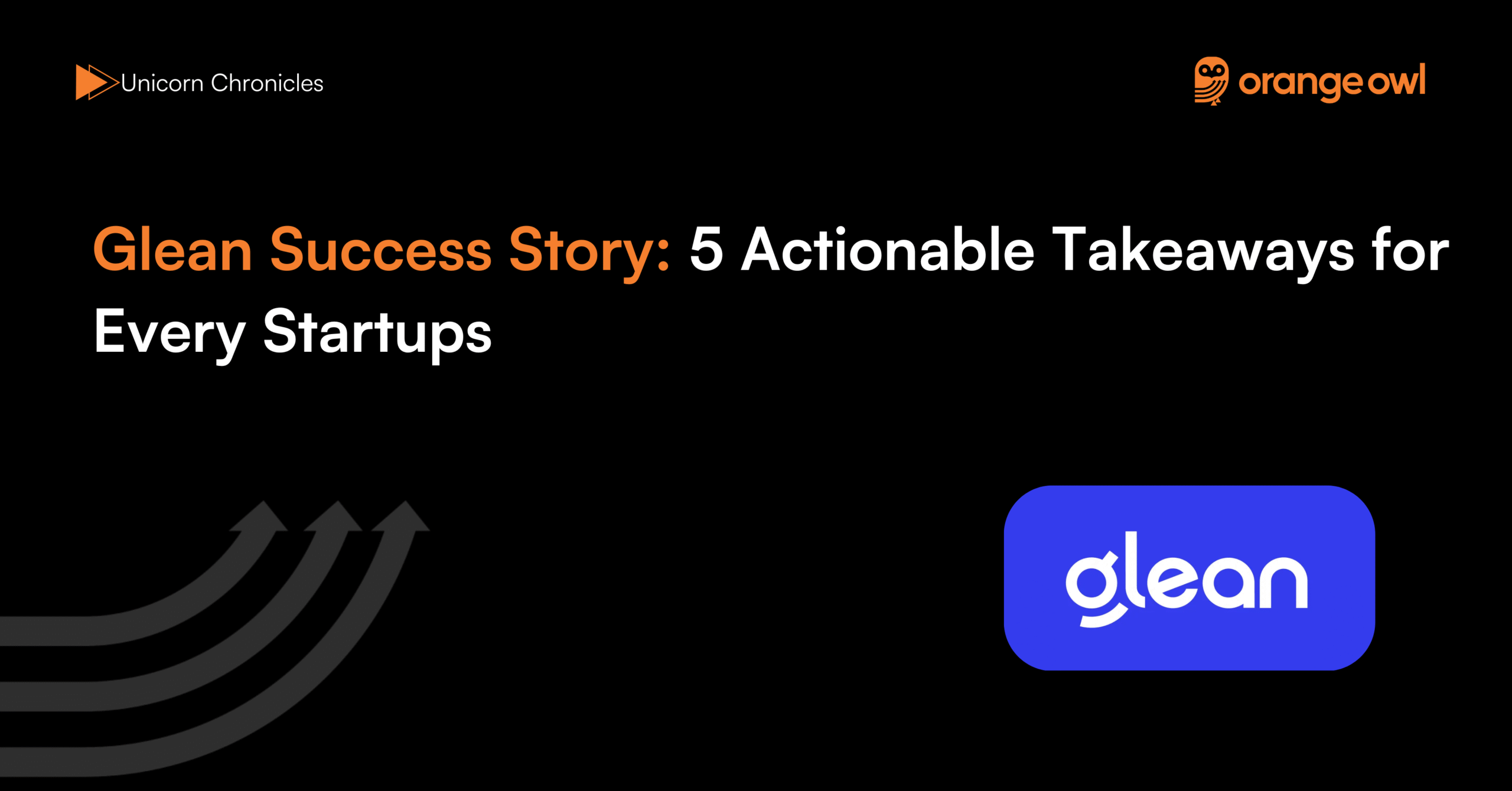Ola Success Story: 5 Innovative Lessons for Every Entrepreneur
Vivek Goel
June 10, 2025

Table of Contents
Introduction
In 2010, two IIT Bombay graduates, Bhavish Aggarwal and Ankit Bhati, founded Ola with a bold vision: to make mobility seamless, affordable, and tech-driven across India. From solving last-mile travel woes to powering over a billion rides across cities, the Ola Cabs success story is one of ambition, agility, and bold reinvention.
Over the years, Ola scaled rapidly, venturing into autos, bikes, cloud kitchens, financial services, and electric vehicles.
It also became India’s answer to Uber, expanding internationally and launching innovations like Ola Play and Ola Electric. At its peak in 2021, Ola was valued at a staggering $7.3 billion. However, in 2025, US-based Vanguard reduced Ola’s valuation to $1.25 billion, amid slowing growth in the ride-hailing space and increasing competition from Rapido and Uber.
Still, Ola has shown resilience, turning EBITDA profitable in FY24 and narrowing its net losses to just ₹10 crore, down from ₹623 crore a year ago.
Now rebranded as Ola Consumer, the company is regrouping to focus on sustainable, integrated growth. The Ola Cabs success story is no longer just about scale—it’s about navigating headwinds, redefining core strengths, and building long-term impact.
Origin Story
The seeds of Ola Cabs were sown in 2010, when Bhavish Aggarwal, an IIT Bombay graduate, found himself stranded on a highway after a cab driver abruptly cancelled the trip mid-way, demanding more money. What could’ve been a frustrating one-off experience instead became the spark for one of India’s most iconic startups. Along with Ankit Bhati, a fellow IITian and skilled coder, Bhavish decided to take on India’s chaotic urban mobility system—one ride at a time.
At the time, the idea of booking a cab through an app was almost unheard of. Local travel was dominated by unregulated operators, pricing was opaque, and customer experience was rarely a priority. Bhavish and Ankit saw an opportunity to change that through technology. They weren’t just trying to digitise transportation—they wanted to reimagine it.
“We didn’t start with the idea of building a billion-dollar company,” Bhavish once said. “We started with a problem we wanted to solve—making mobility reliable and accessible.”
From a single-room office in Mumbai, Ola began as a basic web-based cab booking platform. There was no mobile app, no funding, and no fleet—just relentless hustle. Bhavish even drove cabs himself in the early days to understand what drivers and riders truly needed. That hands-on approach became core to Ola’s DNA.
The breakthrough came in 2011 when Ola raised seed funding from Tiger Global, which allowed them to build out their app, expand city-wise, and lay the foundation for what would eventually become a full-stack mobility platform.
As Bhavish put it in another interview: “The idea wasn’t to disrupt taxis—it was to build mobility as a service for a billion Indians.”
This origin story wasn’t just about fixing a broken system. It was about pioneering a new category, led by tech-first thinking, deep user empathy, and bold execution—all of which would become Ola’s signature in the years to come.
Business Landscape and Challenges
When Ola Cabs entered India’s urban transportation space in 2010, it faced a deeply fragmented and unorganised market dominated by traditional auto-rickshaws, local taxi operators, and patchy public transport systems. The ecosystem was riddled with issues: inconsistent service quality, lack of transparent pricing, driver unreliability, and poor customer experience. India’s mobility landscape was still largely offline, cash-driven, and underserved, especially outside major metros.
More importantly, the ride-hailing concept itself was new and unproven in India. Smartphone penetration was growing but far from universal, and many customers were still wary of booking rides through apps. Drivers, too, were hesitant to adopt technology, often sceptical about income stability and payments.
Ola’s early challenges were significant:
- Building Consumer Trust: Convincing millions of Indian commuters to switch from traditional taxis or autos to an app-based model required changing deep-rooted habits and overcoming scepticism about safety, pricing, and convenience.
- Driver Adoption and Engagement: Unlike conventional taxis, Ola needed to onboard thousands of independent drivers who were mostly unfamiliar with digital platforms. Ensuring driver satisfaction and loyalty, while managing fleet quality, was a complex task.
- Fragmented Infrastructure: Urban traffic congestion, poor road conditions, and regulatory hurdles in different cities made scaling a uniform ride experience difficult.
- Cash Payments and Payment Infrastructure: India’s digital payment ecosystem was still nascent. Enabling smooth payments for rides, while managing cash and wallet options, was operationally challenging.
However, Ola turned these obstacles into growth levers by focusing on technology, local partnerships, and a customer-first approach. They introduced features like transparent pricing, live ride tracking, and cash payments alongside digital wallets, tailored for Indian market realities.
Bhavish Aggarwal once said, “We weren’t just building a taxi app, we were creating a new mobility culture in India.”
By actively engaging with driver communities, investing in driver incentives, and expanding rapidly across cities, Ola built one of India’s largest and most trusted ride-hailing platforms. This early foundation positioned Ola to capitalise on India’s smartphone boom and urbanisation trends, making affordable, reliable mobility accessible for millions.
Growth Strategies
Ola’s rapid growth was driven by a combination of technology innovation, market expansion, and strong driver partnerships. From the beginning, Ola understood that scaling in India meant addressing the unique needs of diverse cities and consumers. The company focused on hyperlocal penetration by entering tier 2 and tier 3 cities early, capturing markets largely ignored by competitors. This broad reach helped Ola build a massive user base beyond metros.
A key growth lever was Ola’s technology-driven platform. The company developed an intuitive app offering features such as real-time ride tracking, transparent pricing, and multiple vehicle options — including cabs, autos, and bikes. Digital payments and seamless booking enhanced convenience for both riders and drivers. Ola’s focus on driver engagement through incentives, flexible earnings, and vehicle leasing ensured a steady supply of drivers during peak hours, directly supporting growth.
Additionally, Ola diversified its offerings by launching bike taxis and electric vehicles, creating new revenue streams and catering to evolving customer preferences. Strategic partnerships with digital payment platforms and integrations with navigation apps helped improve user experience and accessibility.
Bhavish Aggarwal emphasised this approach: “Our goal was never just to build a cab service; it was to transform urban transportation across India by making it accessible, affordable, and reliable.”
These growth strategies allowed Ola to become a dominant player in the ride-hailing market and laid the foundation for its expansion into adjacent mobility services — a crucial part of the Ola Cabs success story.
Marketing Strategy
Ola’s marketing approach played a crucial role in its rise, focusing on localised campaigns, brand trust, and customer engagement rather than just mass advertising. Understanding India’s diverse markets, Ola crafted region-specific promotions that resonated with local languages, cultures, and preferences. This hyperlocal marketing helped build strong connections with users beyond metro cities.
The company leveraged digital marketing channels—including social media, app-based notifications, and influencer partnerships—to maintain direct communication with its rapidly growing customer base. Ola’s referral programs encouraged users to invite friends and family, fueling organic growth and loyalty.
Brand trust was reinforced through prominent celebrity endorsements and partnerships, notably with Bollywood stars, which helped elevate Ola’s image as a reliable and aspirational service. At the same time, Ola focused on customer experience by running campaigns around safety measures, driver training, and transparent pricing, addressing concerns of first-time users.
Bhavish Aggarwal highlighted this consumer-first approach: “We believed that trust is earned, not bought. Our marketing was designed to build lasting relationships, not just quick transactions.”
Ola also invested heavily in promotions tied to festivals and local events, driving spikes in usage while aligning with consumer sentiment. These strategies combined to create a strong, trusted brand and sustained user engagement — a vital part of the Ola Cabs success story.
5 Innovative Lessons for Every Entrepreneur
1. Solve for India, Not Just Urban India
Ola succeeded by localising its business model for India’s diverse geography and customer segments. While most competitors focused only on metro cities, Ola expanded aggressively into Tier 2 and Tier 3 towns, offering auto-rickshaws, shared rides, and even bike taxis. This inclusive approach allowed it to build scale faster and tap into underserved markets.
Lesson: Don’t just chase the premium market—solve for the masses, and the scale will follow.
2. Use Technology to Create Operational Leverage
From GPS-based ride tracking to in-app SOS buttons and real-time pricing, Ola embedded technology across its operations to enhance safety, optimise driver allocation, and improve customer experience. Their tech stack wasn’t just for show—it drove measurable efficiency in one of the most logistically complex sectors.
Lesson: In operationally heavy industries, technology is your biggest multiplier—invest early and meaningfully.
3. Build a Two-Sided Network with Empathy
Ola’s growth wasn’t just driven by customer acquisition—it focused equally on empowering drivers with incentives, training, and micro-financing for vehicle ownership. This helped build a loyal supply base, even in the face of intense competition.
As Bhavish Aggarwal said, “Drivers are our partners. Their growth defines our success.”
Lesson: For platforms, respect both sides of the ecosystem—neglecting one is a recipe for imbalance.
4. Think Ecosystem, Not Just Product
Ola didn’t stop at ride-hailing. It expanded into Ola Electric, Ola Money, and even cloud kitchens, aiming to build an entire mobility and commerce ecosystem. This diversification wasn’t random—it was built on the back of consumer data, brand trust, and platform stickiness.
By solving adjacent problems for the same customer base, Ola increased lifetime value and reduced dependency on a single revenue stream.
Lesson: Once you establish a core use case, build adjacencies that add value and deepen engagement—ecosystems are harder to disrupt than standalone products.
5. Adapt Quickly to Policy and Market Shifts
From state-level bans to regulatory scrutiny on surge pricing, Ola had its fair share of challenges. But instead of resisting, Ola often worked with authorities, introduced compliant pricing models, and adapted fleet operations swiftly.
This willingness to engage with the system rather than fight it allowed Ola to scale sustainably in a complex policy landscape.
Lesson: In fast-changing markets like India, regulatory agility is as crucial as product-market fit—stay flexible, and always be ready to pivot.
Conclusion
Ola’s journey from a scrappy startup to India’s most recognisable mobility brand is a masterclass in ambition, adaptation, and audacity. In a country as complex and chaotic as India, Ola didn’t just introduce app-based cab booking—it redefined how Indians move. By localising its offerings, embracing technology at scale, building empathy-driven partnerships with drivers, and expanding into electric mobility, Ola became more than a service—it became an ecosystem.
More importantly, Ola’s story is not just about transportation innovation—it’s about problem-solving at scale. Whether navigating regulatory mazes or reaching the underserved in small towns, Ola consistently chose to solve for India in its entirety. For founders and operators, Ola offers a living blueprint: think big, build fast, and adapt even faster. As Bhavish Aggarwal puts it,
“If we want to solve India’s problems, we have to think like India—diverse, layered, and full of possibility.”
In doing so, Ola didn’t just build a company. It built a movement.



